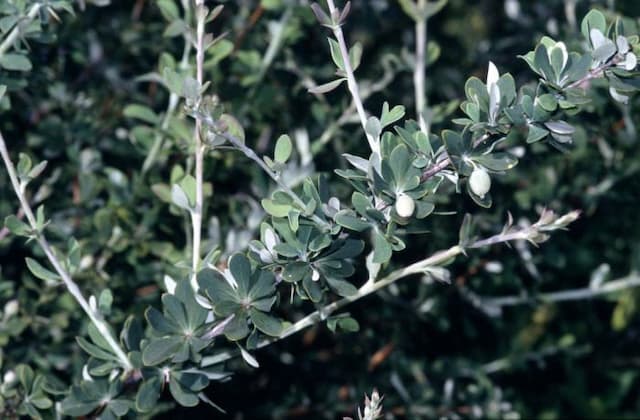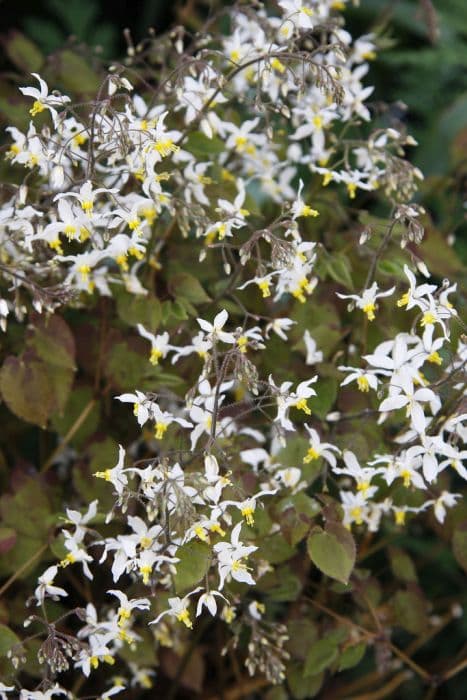Japanese Barberry Berberis thunbergii 'Kelleriis' (v)

ABOUT
The plant known as Kelleris Barberry is a visually striking ornamental shrub that is widely admired for its aesthetic appeal in gardens and landscapes. The main attraction of this plant lies in its foliage, which takes on a beautiful range of colors throughout the year. The leaves are small and oval-shaped with a characteristic sharp edge. Springtime ushers in fresh new leaves with a vibrant, perhaps reddish or purplish hue, providing a striking contrast to the drabber colors of late winter. As the seasons progress, the colors of the leaves intensify and may shift through various shades of red, purple, or even a deep, reddish-purple, offering a dynamic visual display that continuously evolves. When autumn arrives, the leaves may transform yet again, potentially featuring warm autumnal colors that are highly valued in garden design for their ability to add depth and warmth to the landscape. In addition to the striking foliage, Kelleris Barberry is adorned with small flowers during the blossoming season. The blooms are typically clustered in small groups and can vary in color, but often appear as a soft yellow, adding a delicate touch to the overall appearance of the plant. These flowers may give way to small, bright red berries that can attract birds and other wildlife to the garden. The overall texture of this plant is dense and bushy, giving it a substantial presence in the landscape. Its branches are sturdy, and it has a naturally rounded to slightly arching growth habit, with the foliage often densely covering the branches, making it effective as a hedge or a stand-alone feature in a garden setting. Kelleris Barberry's various characteristics, such as the color-changing leaves, the small but attractive flowers, and the bright berries, combine to create a diverse and engaging visual experience, ensuring that the plant remains appealing through multiple seasons and can serve as a versatile and ornamental addition to gardens without the need to reference its specific dimensions.
About this plant
 Names
NamesFamily
Berberidaceae.
Synonyms
Keller's Barberry, Japanese Barberry.
Common names
Berberis thunbergii 'Kelleris' (v).
 Toxicity
ToxicityTo humans
The plant commonly known as Japanese Barberry (Berberis thunbergii 'Kelleriis') may cause mild toxicity if ingested by humans. While not considered highly poisonous, some parts of the plant contain alkaloids such as berberine that, if consumed in significant amounts, could lead to gastrointestinal discomfort, characterized by nausea, vomiting, diarrhea, and possibly a sense of lethargy. It is generally recommended to avoid ingesting parts of this plant to prevent these unpleasant symptoms.
To pets
Similar to its effects on humans, Japanese Barberry (Berberis thunbergii 'Kelleriis') may be mildly toxic to pets if ingested. The alkaloids present in the plant, particularly berberine, can cause gastrointestinal upset in animals, including symptoms such as vomiting and diarrhea. In severe cases, ingestion can also lead to lethargy or other signs of systemic involvement. It is advisable to keep pets away from this plant to avoid potential health issues.
 Characteristics
CharacteristicsLife cycle
Perennials
Foliage type
Deciduous
Color of leaves
Varies
Flower color
Yellow
Height
2 feet (0.61 meters)
Spread
3 feet (0.91 meters)
Plant type
Shrub
Hardiness zones
4
Native area
Japan
Benefits
 General Benefits
General Benefits- Decorative Appeal: Berberis thunbergii 'Kelleriis' offers stunning foliage that changes color through the seasons, providing year-round visual interest.
- Drought Tolerance: Once established, this plant can tolerate periods of low water, making it suitable for drought-prone areas.
- Low Maintenance: It requires minimal care beyond the occasional pruning, making it ideal for gardeners looking for low-maintenance options.
- Pest Resistance: This variety of barberry is resistant to many pests, reducing the need for chemical interventions.
- Erosion Control: Its root system helps to stabilize soil and prevent erosion on slopes and banks.
- Wildlife Habitat: Provides food and shelter for birds and other wildlife, adding to the biodiversity of the garden ecosystem.
- Adaptability: Can grow in a wide range of soil types and conditions, from full sun to partial shade.
- Hedging and Borders: It is commonly used for hedges, borders, and garden partitions due to its dense growth habit.
- Seasonal Interest: Produces small, yellow flowers in the Spring and red berries in the Fall, offering multi-seasonal interest.
- Privacy: When planted in groups, it can act as a privacy screen or windbreak.
 Medical Properties
Medical PropertiesThis plant is not used for medical purposes.
 Air-purifying Qualities
Air-purifying QualitiesThis plant is not specifically known for air purifying qualities.
 Other Uses
Other Uses- Japanese barberry 'Kelleriis' can be used as a natural food dye, providing an attractive reddish color to various foods due to its pigmented foliage and berries.
- The sharp thorns of the plant can serve as a natural deterrent against wildlife and can be strategically planted to protect more vulnerable plants in a garden.
- In crafts, the stems and thorns of Japanese barberry can be incorporated into rustic wreaths or decorative displays that require a spiky texture.
- The dense branching habit of the plant makes it an excellent option for creating intricate topiaries in formal gardens or as a standalone sculptural element.
- Japanese barberry can be used in educational settings to teach about invasive species and the impact they can have on local ecosystems and biodiversity.
- Photographers and artists may use the vibrant red foliage as a natural backdrop or as an inspiring subject for capturing the beauty of different seasons.
- In survival situations, the wood of Japanese barberry can be used to make small tools or as tinder for starting fires under controlled conditions.
- Fallen leaves and pruned branches can be composted to create a rich organic material that benefits garden soil.
- The fruit of the Japanese barberry can be used to create wildlife-friendly garden spaces that attract birds and other berry-eating animals.
- During festive seasons, the bright berries can be used to make natural decorations, providing a pop of color to holiday arrangements.
Interesting Facts
 Feng Shui
Feng ShuiThe Japanese Barberry is not used in Feng Shui practice.
 Zodiac Sign Compitability
Zodiac Sign CompitabilityThe Japanese Barberry is not used in astrology practice.
 Plant Symbolism
Plant Symbolism- Toughness: Japanese Barberry, including the 'Kelleris' variety, is known for its hardiness and ability to thrive in challenging conditions. It symbolizes resilience and the ability to withstand hardships.
- Protection: With its sharp thorns, the Japanese Barberry is often associated with protection and defense, suggesting a barrier or shield against negative forces.
- Adaptability: This plant can adapt to various environments and soil types, representing flexibility and the willingness to adjust to new situations.
 Water
WaterJapanese Barberry prefers evenly moist soil, but it's quite drought-tolerant once established. Water the plant deeply once a week, providing about 1 to 1.5 gallons of water for each plant. During periods of extreme heat or drought, increase watering to twice a week. In the fall, reduce watering to help the plant harden off for winter. Ensure the soil drains well to prevent root rot.
 Light
LightJapanese Barberry thrives in full sun to partial shade. The ideal location receives at least 6 hours of direct sunlight per day, though the plant can tolerate some shade, especially in hotter climates. Avoid deep shade, as it can lead to poor growth and fewer vibrant leaves.
 Temperature
TemperatureFor Japanese Barberry, the preferred temperature range is between 50°F and 70°F. It can withstand temperatures as low as -30°F and as high as 85°F but thrives in moderate climates. Protect the plant from extreme heat by providing shade or mulch to cool the root zone.
 Pruning
PruningPrune Japanese Barberry in late winter or early spring to maintain shape and remove any dead or diseased branches. Pruning encourages new growth and should be done annually. Cut back up to one-third of older stems to promote rejuvenation, focusing on shaping the plant and improving air circulation.
 Cleaning
CleaningAs needed
 Soil
SoilJapanese Barberry thrives in well-draining soil composed of loam, sand, and organic matter like compost or peat moss. The pH level should be slightly acidic to neutral, ranging from 6.0 to 7.5. It is essential to ensure good drainage to prevent root rot.
 Repotting
RepottingJapanese Barberry typically does not require frequent repotting and can be repotted every 2 to 3 years. It's best to repot in the spring before new growth begins. Ensure that the new pot has adequate drainage holes.
 Humidity & Misting
Humidity & MistingJapanese Barberry is tolerant of a wide range of humidity levels and can adapt to the ambient outdoor humidity in most climates. It does not have specific humidity requirements and does well in average garden conditions.
 Suitable locations
Suitable locationsIndoor
Keep in bright light, well-drained soil, water sparingly.
Outdoor
Plant in sun/partial shade, well-drained soil, moderate water.
Hardiness zone
4-8 USDA
 Life cycle
Life cycleBerberis thunbergii 'Kelleriis', commonly known as the Kelleriis Japanese Barberry, begins its life cycle when seeds germinate in spring, with soil warmth and moisture triggering their growth. Seedlings continue to develop into young plants, forming a dense, compact shrub with small, round leaves and distinctive pink to reddish-purple foliage. As the plant matures, it enters its flowering stage, usually in mid-spring, producing small, yellow flowers that may be somewhat inconspicuous against the foliage. Following pollination, which is often assisted by insects, the flowers develop into bright red, oblong fruits by late summer to fall, which are eaten and dispersed by birds and other wildlife. The shrub typically achieves full size and shape within a few years and can live for several decades, with minimal care once established. Throughout the years, the Kelleriis Japanese Barberry will go through seasonal cycles of growth and dormancy, shedding its leaves in the fall and entering a period of winter dormancy before resuming growth each spring.
 Propogation
PropogationPropogation time
Early Spring
The Japanese Barberry 'Kelleriis,' scientifically known as Berberis thunbergii 'Kelleriis' (v), is most commonly propagated through softwood cuttings. This technique is typically carried out in the late spring to early summer when the new growth is still flexible but has begun to mature. Cuttings should be about 4 to 6 inches long and contain a few leaves. The lower end of the cutting is dipped in rooting hormone to encourage root growth, and then planted in a well-draining soil mix. The environment should be kept humid, which can be achieved by covering the cuttings with a plastic dome or misting regularly until roots have established, generally within 4 to 8 weeks.









